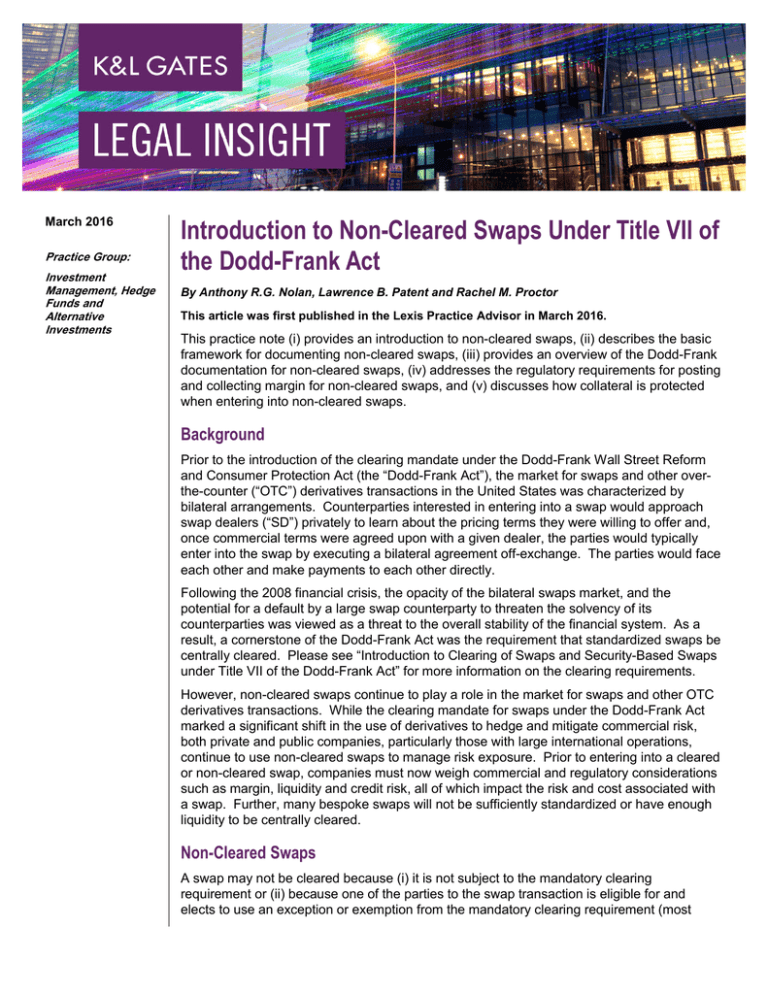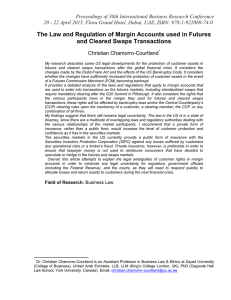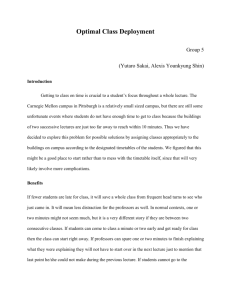Introduction to Non-Cleared Swaps Under Title VII of the Dodd-Frank Act
advertisement

March 2016 Practice Group: Investment Management, Hedge Funds and Alternative Investments Introduction to Non-Cleared Swaps Under Title VII of the Dodd-Frank Act By Anthony R.G. Nolan, Lawrence B. Patent and Rachel M. Proctor This article was first published in the Lexis Practice Advisor in March 2016. This practice note (i) provides an introduction to non-cleared swaps, (ii) describes the basic framework for documenting non-cleared swaps, (iii) provides an overview of the Dodd-Frank documentation for non-cleared swaps, (iv) addresses the regulatory requirements for posting and collecting margin for non-cleared swaps, and (v) discusses how collateral is protected when entering into non-cleared swaps. Background Prior to the introduction of the clearing mandate under the Dodd-Frank Wall Street Reform and Consumer Protection Act (the “Dodd-Frank Act”), the market for swaps and other overthe-counter (“OTC”) derivatives transactions in the United States was characterized by bilateral arrangements. Counterparties interested in entering into a swap would approach swap dealers (“SD”) privately to learn about the pricing terms they were willing to offer and, once commercial terms were agreed upon with a given dealer, the parties would typically enter into the swap by executing a bilateral agreement off-exchange. The parties would face each other and make payments to each other directly. Following the 2008 financial crisis, the opacity of the bilateral swaps market, and the potential for a default by a large swap counterparty to threaten the solvency of its counterparties was viewed as a threat to the overall stability of the financial system. As a result, a cornerstone of the Dodd-Frank Act was the requirement that standardized swaps be centrally cleared. Please see “Introduction to Clearing of Swaps and Security-Based Swaps under Title VII of the Dodd-Frank Act” for more information on the clearing requirements. However, non-cleared swaps continue to play a role in the market for swaps and other OTC derivatives transactions. While the clearing mandate for swaps under the Dodd-Frank Act marked a significant shift in the use of derivatives to hedge and mitigate commercial risk, both private and public companies, particularly those with large international operations, continue to use non-cleared swaps to manage risk exposure. Prior to entering into a cleared or non-cleared swap, companies must now weigh commercial and regulatory considerations such as margin, liquidity and credit risk, all of which impact the risk and cost associated with a swap. Further, many bespoke swaps will not be sufficiently standardized or have enough liquidity to be centrally cleared. Non-Cleared Swaps A swap may not be cleared because (i) it is not subject to the mandatory clearing requirement or (ii) because one of the parties to the swap transaction is eligible for and elects to use an exception or exemption from the mandatory clearing requirement (most Introduction to Non-Cleared Swaps Under Title VII of the Dodd-Frank Act commonly, the commercial end-user exception). For an explanation of the commercial enduser exception, please refer to the practice note, “Introduction to the Commercial End-User Exception to Mandatory Clearing of Swaps and Security-Based Swaps Under Title VII of the Dodd-Frank Act.” Generally speaking, the non-cleared swap market typically consists of non-standard, complex bespoke products (as opposed to a cleared transaction which may be considered standard and simple). These are products that do not fit the eligibility requirements of central clearinghouses. Non-Cleared Swap Documentation Parties interested in entering into a non-cleared, off-exchange swap typically execute an International Swaps and Derivatives Association (“ISDA”) Master Agreement (“ISDA Master Agreement”). ISDA is a global trade organization for participants in the swaps and OTC derivatives market. ISDA developed and published the ISDA Master Agreement, as well as a suite of related documents, to streamline the documentation and negotiation of swaps and OTC derivatives amongst its members and thereby, reduce credit and legal risk within the OTC derivatives market. The suite of documents includes (i) ISDA Master Agreement, (ii) Schedule, (iii) Credit Support Annex, (iv) Confirmations, and (v) Definitions. ISDA Master Agreement The ISDA Master Agreement is a master agreement establishing standard terms and conditions applicable to all transactions entered into between the parties during the term of the agreement, as well as providing for netting of a series of transactions between parties. The ISDA Master Agreement is a boilerplate document that is never modified. However, the parties are able to negotiate the terms through a Schedule to the ISDA Master Agreement, discussed below. The ISDA Master Agreement includes standard terms such as counterparty representations, events of default, termination events, bankruptcy, and netting of payments. The two main versions commonly used in the OTC derivatives market are (i) the 2002 ISDA Master Agreement, and (ii) the 1992 ISDA Master Agreement (Multicurrency - Cross Border). For more information on the ISDA Master Agreement, see “A Practical Guide to the ISDA Master Agreement.” Schedule to the ISDA Master Agreement The Schedule to the ISDA Master Agreement allows parties to make certain elections and changes to the standard terms found in the ISDA Master Agreement. Common terms that parties negotiate in the Schedule are counterparty representations, credit support provisions, cross-default provisions, early termination provisions and additional termination events. Credit Support Annex One election that the parties may make under the Schedule is to collateralize their obligations using the Credit Support Annex (“CSA”). Similar to the ISDA Master Agreement, the CSA is a boilerplate document that is not subject to negotiation generally. However, Paragraph 13 to the CSA operates like the Schedule to the ISDA Agreement and allows the 2 Introduction to Non-Cleared Swaps Under Title VII of the Dodd-Frank Act parties to modify and add to the terms of the CSA. Common terms that parties negotiate in accordance with Paragraph 13 are the eligible collateral, threshold amounts and how to hold and use posted collateral. Confirmations The parties document the details of individual transactions entered into under the ISDA Master Agreement using confirmations, as the term is defined in the ISDA Master Agreement (“Confirmations”). In addition to specifying the terms of the individual transaction, the Confirmation will generally include language that provides for the Confirmation to be incorporated and form a part of the ISDA Master Agreement. However, the Confirmation will also generally state that, in the event of an inconsistency, the terms of the Confirmation will govern. Accordingly, it is important to review the Confirmation to confirm that all references to the ISDA Master Agreement and Schedule are accurate, and that no additional legal provisions are added that would conflict with the ISDA Master Agreement or Schedule. ISDA provides template confirmations for different types of products that parties may use, but parties generally use one of their own forms. Definitions The ISDA Master Agreement contains definitions, but ISDA has also developed and published definitions for certain products. Some parties prefer to incorporate these more detailed definitions into their Schedules and/or Confirmations. Accordingly, it is important to be aware of and review what definitions are being referenced. ISDA Dodd-Frank Protocols and Questionnaires In response to the regulatory requirements imposed by Title VII of the Dodd-Frank Act with respect to swaps, ISDA developed and published the ISDA August 2012 D-F Protocol and the ISDA March 2013 D-F Protocol (the “DF Protocols”) to help counterparties comply with their obligations. Please see “Introduction to the United States Regulation of Swaps and Security-Based Swaps Under Title VII of the Dodd-Frank Act” for an overview of the regulatory requirements under Title VII of Dodd-Frank. The DF Protocols supplement the terms of the ISDA Master Agreement and are intended to satisfy certain counterparty requirements upon execution of a swap. While this practice note will not discuss the adherence process in detail, one aspect of the Dodd-Frank documentation that we will highlight is the DF Questionnaire. Each of the DF Protocols contains a DF Questionnaire. ISDA developed and published the questionnaires to assist swap dealers in complying with their regulatory requirements prescribed by the Commodity Futures Trading Commission (“CFTC”). The August 2012 DF Protocol and the March 2013 DF Protocol each address a different set of CFTC rules, so both of the questionnaires are necessary. The DF questionnaires are formatted in a userfriendly, grid style answer sheet. The August 2012 DF Questionnaire is often referred to as the “know your counterparty” questionnaire. The information requested on this questionnaire includes: (i) the counterparty’s name, address, and principal occupation; (ii) the counterparty’s legal entity identifier; (iii) the identity of and address of any guarantor; (iv) the identity of and address of 3 Introduction to Non-Cleared Swaps Under Title VII of the Dodd-Frank Act any third person exercising control over the counterparty’s position; (v) the identity of and address of any designated valuation agent; (vi) entity representations and (vii) notice addresses. The questionnaire also requires the counterparty to elect which schedules to the DF Supplement will apply. Counterparties will want to review the applicability of the six schedules; however, generally, the common schedules to apply for counterparties are (a) Schedule 1: Defined Terms, (b) Schedule 2: Agreements between a Swap Dealer and Any Other Party and (c) Schedule 3: Institutional Suitability Safe Harbors for Non-Special Entities. The August 2012 DF Questionnaire can be found here. The March 2013 DF Questionnaire asks for the following information: (i) the counterparty’s legal entity identifier, (ii) whether the counterparty is an SD, (iii) whether the counterparty is a financial entity or financial company, (iv) the counterparty’s email address for notice purposes and (v) whether the counterparty is electing the commercial end-user exception. For an explanation of the commercial end-user exception, please refer to the practice note “Introduction to the Commercial End-User Exception to Mandatory Clearing of Swaps and Security-Based Swaps Under Title VII of the Dodd-Frank Act.” The questionnaire also asks the counterparty to elect which schedules to the DF Supplement will apply. Counterparties should review the applicability of the four schedules; however, counterparties will focus on the applicability of Schedule 3: Calculation of Risk Valuations and Dispute Resolution (which generally depends on whether the counterparty is using a designated valuation agent) and Schedule 4: Portfolio Reconciliation (which generally depends on the amount of trades the counterparty enters into). The March 2013 DF Questionnaire can be found here. Margin Requirements for Non-Cleared Swaps When entering into a non-cleared swap, counterparties will be required to post and collect an initial margin, and will be required to maintain a variation margin throughout the term of the deal. Background on Initial and Variation Margin Well-designed margin requirements are intended to protect both parties to a trade, as well as the overall financial system. Margin requirements serve as both a check on risk-taking that might exceed a party’s financial capacity and as a resource that can limit losses when there is a failure by a party to meet its obligations. There are two types of margin: initial and variation. Initial margin protects against potential future exposure and serves as a performance bond against potential future losses. If a party fails to meet its obligation to pay variation margin, resulting in a default, the other party may use initial margin to cover some or all of any loss. Variation margin serves as a mechanism for periodically recognizing changes in the value of open positions and reducing unrealized losses to zero. Open positions are marked to their current market value each day and funds are transferred between the parties to reflect any change in value since the previous time the positions were marked. Variation margin is used to prevent losses from accumulating over time and reduces both the change of default and the size of any default should one occur. 4 Introduction to Non-Cleared Swaps Under Title VII of the Dodd-Frank Act Banking Regulators’ Joint Final Rule on Swap Margin Requirements The Office of the Comptroller of the Currency, the Federal Reserve Board, the Federal Deposit Insurance Corporation, the Farm Credit Administration, and the Federal Housing Finance Agency (collectively, the “Banking Regulators”) approved a joint final rule establishing margin requirements for non-cleared swaps. 12 CFR Parts 45, 237, 349, 624, 1221. The initial and variation margin requirements generally apply to posting and collecting minimum amounts between counterparties. However, it is important to note that these rules only establish minimum amounts of initial and variation margin, but they do not prevent or discourage counterparties from collecting or posting greater amounts. Who do these regulations apply to? These regulations apply to any SD registered with the CFTC, or a security-based swap dealer registered with the Securities and Exchange Commission whose primary regulator is one of the Banking Regulators. By their application, the regulations will affect counterparties that are financial end-users. Financial end-users will include, among others, registered investment companies, private funds, commodity pools and pension plans. Under the final rule, certain transactions with certain non-financial end users and other financial counterparties are exempt from the Banking Regulators’ margin requirements. A commercial end-user that is neither an SD nor a financial end-user and engages in swaps to hedge commercial risk is exempt from these regulations. However, while the final rule does not impose margin requirements, this does not prohibit a covered swap entity from requesting margin as part of the transaction from a commercial end-user. Initial Margin The initial margin requirements apply to SDs who enter into non-cleared swaps with financial end-users with material swaps exposure. A financial end-user has “material swaps exposure” when the entity and its affiliates have an average daily aggregate notional amount of non-cleared swaps, non-cleared security-based swaps, foreign exchange forwards and foreign exchange swaps with all counterparties for June, July and August of the previous calendar year that exceeds $8 billion. An SD transacting with a financial end-user counterparty that has a material swaps exposure must post and collect a minimum amount of margin. If certain conditions are met, an SD may use an internal margin model to establish the level of initial margin. Otherwise, the regulations establish standardized amounts of initial margin based upon a percentage of notional exposure ranging from one percent (1%) for interest rate or cross-currency swaps with 0-2 years duration, to fifteen percent (15%) for commodity, equity and other swaps. Variation Margin The final rule requires an SD to collect and post variation margin with respect to non-cleared swaps for swap transactions with a financial end user, regardless of whether or not the financial end-user has a “material swaps exposure.” The SD is required to collect or post (as applicable) variation margin on non-cleared swaps in an amount that is equal to the increase or decrease in the value of the swap since the counterparties’ previous exchange of variation margin. The final rule provides that variation margin be posted or collected on a T+1 5 Introduction to Non-Cleared Swaps Under Title VII of the Dodd-Frank Act timeframe. The variation margin must be posted or collected no less than once per business day, beginning on the business day following execution of the swap transaction. Types of Collateral Eligible for Margin The Banking Regulators provide that counterparties may use various types of collateral to satisfy their margin requirements. Examples of eligible collateral are (i) U.S. dollars, (ii) cash in any currency in which payment obligations under the swap are required to be settled, (iii) U.S. Treasury securities, (iv) a security that is issued by, or unconditionally guaranteed as to the timely payment of principal and interest by a U.S. government agency (other than the U.S. Department of Treasury) whose obligations are fully guaranteed by the full faith and credit of the United States government, (v) certain corporate debt securities, and (vi) gold. Compliance Dates The Banking Regulators created a phased-in compliance schedule for the margin requirements. The compliance dates for the initial margin requirements range from September 1, 2016 to September 1, 2020 based upon an average daily aggregate notional amount of swaps over a certain calculation period. On September 1, 2016, counterparties will have to comply with the initial margin requirements where both the SD (combined with all its affiliates) and its counterparty (combined with all its affiliates) have an average daily aggregate notional amount of covered swaps for March, April and May of 2016 that exceeds $3 trillion. In calculating the amount of covered swaps, counterparties must count noncleared swaps, non-cleared security-based swaps, foreign exchange forwards and foreign exchange swaps. For variation margin, the compliance dates are September 1, 2016 and March 1, 2017. Similar to initial margin, the compliance dates are based on a materiality standard. Counterparties will have to comply with the variation margin requirements beginning September 1, 2016 if the average notional amount exceeds $3 trillion as referred to above. Otherwise, any SD must comply with the variation margin requirements for swaps with financial end users beginning March 1, 2017. Collateral Protection for Non-Cleared Swaps Initial margin must be segregated, and the collateral posted by each side must be held with a custodian that is independent of both the SD and the counterparty. An SD is allowed to reinvest a counterparty’s segregated initial margin, but there are limits to the reinvestment. The SD must follow certain standards for the investment of a counterparty’s funds, which are similar to those set by the CFTC for cleared swaps and exchange-traded futures. There is no requirement to segregate variation margin. CFTC’s Margin Requirements The CFTC adopted its margin requirements for non-cleared swaps on December 16, 2015. 81 Fed. Reg. 635 (January 6, 2016). The CFTC’s regulations are generally consistent with the Banking Regulators’ requirements summarized above. However, as of the end of 2015, the CFTC had not yet adopted final regulations to govern margin on non-cleared swaps in a cross-border transaction, so it remains to be seen if the CFTC will be consistent with the banking regulators with respect to that aspect of the regulatory framework. 6 Introduction to Non-Cleared Swaps Under Title VII of the Dodd-Frank Act Authors: Anthony R.G. Nolan Lawrence B. Patent Rachel M. Proctor anthony.nolan@klgates.com +1 212 536 4843 lawrence.patent@klgates.com +1 202 778 9219 rachel.proctor@klgates.com +1 503 226 5787 Anchorage Austin Fort Worth Frankfurt Orange County Beijing Berlin Harrisburg Palo Alto Paris Boston Hong Kong Perth Brisbane Houston Pittsburgh Brussels London Portland Charleston Los Angeles Raleigh Charlotte Melbourne Research Triangle Park Chicago Miami Dallas Milan San Francisco Doha Newark Dubai New York São Paulo Seattle Seoul Shanghai Singapore Sydney Taipei Tokyo Warsaw Washington, D.C. Wilmington K&L Gates comprises approximately 2,000 lawyers globally who practice in fully integrated offices located on five continents. The firm represents leading multinational corporations, growth and middle-market companies, capital markets participants and entrepreneurs in every major industry group as well as public sector entities, educational institutions, philanthropic organizations and individuals. For more information about K&L Gates or its locations, practices and registrations, visit www.klgates.com. This publication is for informational purposes and does not contain or convey legal advice. The information herein should not be used or relied upon in regard to any particular facts or circumstances without first consulting a lawyer. © 2016 K&L Gates LLP. All Rights Reserved. 7



